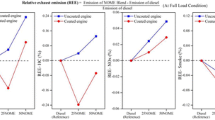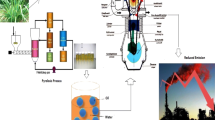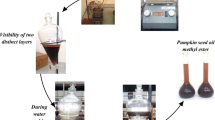Abstract
An increase in energy consumption, fluctuation in oil prices, depletion of fossil fuels, demolition of natural resources and need for less carbon content in fuel induces the way to find an alternative fuel. Biodiesel is the most promising and environment-friendly alternative to the conventional fuel. This paper presents the comparative studies of various non-edible oils in single cylinder, four-stroke diesel engine with eddy current dynamometer. In the present study, cashewnut shell liquid methyl ester, orange methyl ester and neem oil methyl ester were obtained from its respective non-edible oils via transesterification process. Diesel engine was coated with partially stabilized zirconia (PSZ) as thermal barrier coating. Biodiesel samples were blended with diesel in 20:80 ratios. In this work, the following engine characteristics such as brake thermal efficiency (BTE), brake-specific fuel consumption (BSFC), CO, HC, NOx, smoke emissions for both coated and uncoated engine conditions were measured. From the experimentation, it was concluded that orange methyl ester with diesel and neem oil methyl ester with diesel when used as an alternative to the conventional fuel showed higher BTE, lower BSFC along with lower emissions of CO, HC, NOx, and smoke in engine coated with PSZ. This substantiates the dual benefits of PSZ coating with the new alternative fuels on emission reduction.









Similar content being viewed by others
References
Kumar S, Das SRK, Sharma A (2015) Improvement in the performance and emission characteristics of diesel engine fueled with Jatropha methyl ester and tyre pyrolysis oil by addition of nano additives. J Brazilian Soc Mech Sci Eng. doi:10.1007/s40430-015-0454-x
Ananthakumar S, Jayabal S, Thirumal P (2016) Investigation on performance, emission and combustion characteristics of variable compression engine fuelled with diesel, waste plastics oil blends. J Brazilian Soc Mech Sci Eng. doi:10.1007/s40430-016-0518-6
Basha JS, Anand RB (2013) The influence of nano additive blended biodiesel fuels on the working characteristics of a diesel engine. J Brazilian Soc Mech Sci Eng 35:257–264. doi:10.1007/s40430-013-0023-0
Venkateswarlu K, Murthy BSR, Subbarao VV (2016) An experimental investigation to study the effect of fuel additives and exhaust gas recirculation on combustion and emissions of diesel–biodiesel blends. J Brazilian Soc Mech Sci Eng 38:735–744. doi:10.1007/s40430-015-0376-7
Kivevele TT, Huan Z (2015) An analysis of fuel properties of fatty acid methyl ester from Manketti seeds oil an analysis of fuel properties of fatty acid methyl ester from Manketti seeds oil. Int J Green Energy. doi:10.1080/15435075.2014.886579
Hassan NMS, Rasul MG, Harch CA (2015) Modelling and experimental investigation of engine performance and emissions fuelled with biodiesel produced from Australian beauty leaf tree. Fuel. doi:10.1016/j.fuel.2015.02.016
Rashedul HK, Masjuki HH, Kalam MA, Teoh YH, How HG, Rizwanul Fattah IM (2015) Effect of antioxidant on the oxidation stability and combustion–performance–emission characteristics of a diesel engine fueled with diesel–biodiesel blend. Energy Convers Manag 106:849–858. doi:10.1016/j.enconman.2015.10.024
Vairamuthu G, Sundarapandian S, Thangagiri B (2015) Experimental investigations on the influence of properties of Calophyllum inophyllum biodiesel on performance, combustion, and emission characteristics of a DI diesel engine. Int J Ambient Energy. doi:10.1080/01430750.2015.1023838
Fernandes David M, Sousa Raquel MF, De Oliveira Alberto, Morais Sérgio AL, Richter Eduardo M, Muñoz Rodrigo AA (2015) Moringa oleifera: a potential source for production of biodiesel and antioxidant additives. Fuel 146:75–80. doi:10.1016/j.fuel.2014.12.081
Subramanian N, Mahendradas DK, Kasirajan R (2015) Bio-oil separation from potential non-edible urban waste source Putranjiva roxburghii. Sep Sci Technol. doi:10.1080/01496395.2015.1018439
Bora P, Jyoti L, Mausoom M, Deka D (2015) Microemulsion based hybrid biofuels from Thevetia peruviana seed oil: structural and dynamic investigations. Fuel 157:208–218. doi:10.1016/j.fuel.2015.04.075
Arbi I, Mohamed H, Mokbli S, Rashid U, Al-resayes SI (2015) Yucca aloifolia oil methyl esters. Ind Crop Prod 69:257–262. doi:10.1016/j.indcrop.2015.02.029
Senthil R, Silambarasan R, Ravichandiran N (2015) Influence of injection timing and compression ratio on performance, emission and combustion characteristics of Annona methyl ester operated diesel engine. Alex Eng J 54:295–302. doi:10.1016/j.aej.2015.05.008
Rashedul HK, Masjuki HH, Kalam MA, Ashraful AM, Rashed MM, Sanchita I, Shaon T (2014) Performance and emission characteristics of a compression ignition engine running with linseed biodiesel. Rsc Adv 4:64791–64797. doi:10.1039/c4ra14378g
Karthickeyan V, Balamurugan P, Senthil R (2016) Studies on orange oil methyl ester in diesel engine with hemispherical and toroidal combustion chamber. Therm Sci 20 (Accepted for Publication)
Karthickeyan V, Balamurugan P, Senthil R (2016) Production of orange oil methyl ester and experimental investigation on thermal barrier coated diesel engine. Asian J Res Soc Sci Humanit 6:156–178. doi:10.5958/2249-7315.2016.00601.8
Karthickeyan V, Balamurugan P, Senthil R (2016) Investigation of CI engine fueled with ethanol nano additives blended diesel. In: Kumar S, Khanal SK, Yadav YK (eds) Proceedings of the first international conference on recent advances in bioenergy research. Springer proceedings in energy, Springer, India, pp 121–130. doi: 10.1007/978-81-322-2773-1_9
Ashraful AM, Masjuki HH, Kalam MA, Rashedul HK, Habibullah M, Rashed MM, Mosarof MH, Arslan A (2016) Impact of edible and non-edible biodiesel fuel properties and engine operation condition on the performance and emission characteristics of unmodified DI diesel engine. Biofuels 7269:1–14. doi:10.1080/17597269.2015.1132365
Rahimi-Gorji M, Ghajar M, Kakaee A-H, Domiri Ganji D (2016) Modeling of the air conditions effects on the power and fuel consumption of the SI engine using neural networks and regression. J Brazilian Soc Mech Sci Eng. doi:10.1007/s40430-016-0539-1
Mohamedmusthafa M, Sivapirakasam SP, Udayakumar M (2011) Comparative studies on fly ash coated low heat rejection diesel engine on performance and emission characteristics fueled by rice bran and Pongamia methyl ester and their blend with diesel. Energy 36:2343–2351. doi:10.1016/j.energy.2010.12.047
Srithar K, Balasubramanian KA, Vivar M (2012) An experimental investigation on diesel and low heat rejection engines with dual biodiesel blends. Int J Green Energy. doi:10.1080/15435075.2012.738448
Aydin H (2013) Combined effects of thermal barrier coating and blending with diesel fuel on usability of vegetable oils in diesel engines. Appl Therm Eng 51:623–629. doi:10.1016/j.applthermaleng.2012.10.030
Vedharaj S, Vallinayagam R, Yang WM, Saravanan CG, Chou SK, Chua KJE, Lee PS (2014) Reduction of harmful emissions from a diesel engine fueled by Kapok methyl ester using combined coating and SNCR technology. Energy Convers Manag 79:581–589. doi:10.1016/j.enconman.2013.12.056
Mosarof MH, Kalam MA, Masjuki HH, Alabdulkarem A, Habibullah M, Arslan A, Monirul IM (2016) Assessment of friction and wear characteristics of Calophyllum inophyllum and palm biodiesel. Ind Crops Prod 83:470–483. doi:10.1016/j.indcrop.2015.12.082
Rahimi-Gorji M, Gorji TB, Gorji-Bandpy M (2016) Details of regional particle deposition and airflow structures in a realistic model of human tracheobronchial airways: two-phase flow simulation. Comput Biol Med 74:1–17. doi:10.1016/j.compbiomed.2016.04.017
Rahimi-Gorji M, Pourmehran O, Gorji-Bandpy M, Gorji TB (2015) CFD simulation of airflow behavior and particle transport and deposition in different breathing conditions through the realistic model of human airways. J Mol Liq 209:121–133. doi:10.1016/j.molliq.2015.05.031
Holman JP (2007) Experimental techniques for engineers, 7th edn. Tata MCGraw Hill, New Delhi
Mohamedmusthafa M, Sivapirakasam SP, Udayakumar M, Balasubramanian KR (2012) Effects of Al 2 O 3 coating on diesel engine performance, combustion, and emission characteristics fueled by Pongamia methyl ester and its blends with diesel. Environ Prog Sustain Energy 31:147–156. doi:10.1002/ep
Vedharaj S, Vallinayagam R, Yang WM, Chou SK, Chua KJE, Lee PS (2014) Experimental and finite element analysis of a coated diesel engine fueled by cashew nut shell liquid biodiesel. Exp Therm Fluid Sci 53:259–268. doi:10.1016/j.expthermflusci.2013.12.018
Devan PK, Mahalakshmi NV (2009) Performance, emission and combustion characteristics of poon oil and its diesel blends in a DI diesel engine. Fuel 88:861–867. doi:10.1016/j.fuel.2008.11.005
Mofijur M, Masjuki HH, Kalam MA, Atabani AE, Arbab MI, Cheng SF, Gouk SW (2014) Properties and use of Moringa oleifera biodiesel and diesel fuel blends in a multi-cylinder diesel engine. Energy Convers Manag 82:169–176. doi:10.1016/j.enconman.2014.02.073
Rashedul HK, Masjuki HH, Kalam MA, Ashraful AM, Ashrafur Rahman SM, Shahir SA (2014) The effect of additives on properties, performance and emission of biodiesel fuelled compression ignition engine. Energy Convers Manag 88:348–364. doi:10.1016/j.enconman.2014.08.034
Mofijur M, Masjuki HH, Kalam MA, Atabani AE, Rizwanul Fattah IM, Mobarak HM (2014) Comparative evaluation of performance and emission characteristics of Moringa oleifera and palm oil based biodiesel in a diesel engine. Ind Crop Prod 53:78–84. doi:10.1016/j.indcrop.2013.12.011
Devan PK, Mahalakshmi NV (2009) A study of the performance, emission and combustion characteristics of a compression ignition engine using methyl ester of paradise oil–eucalyptus oil blends. Appl Energy 86:675–680. doi:10.1016/j.apenergy.2008.07.008
Aydın S, Sayın C (2014) Impact of thermal barrier coating application on the combustion, performance and emissions of a diesel engine fueled with waste cooking oil biodiesel–diesel blends. Fuel 136:334–340. doi:10.1016/j.fuel.2014.07.074
Karthickeyan V, Balamurugan P, Senthil R (2015) Experimental investigation of tyre pyrolysis oil (TPO) in diesel engine without any engine modification. J Biofuels Bioenerg 1:170–183. doi:10.5958/2454-8618.2015.00018.8
Acknowledgments
The authors would like to express their thanks to University Grants Commission- South Eastern Regional Office, Hyderabad, India for financial support through Minor research project for teachers with grant number 4-4/2013-14 (MRP- SEM/UGC- SERO).
Author information
Authors and Affiliations
Corresponding author
Additional information
Technical Editor: Luis Fernando Figueira da Silva.
Rights and permissions
About this article
Cite this article
Karthickeyan, V., Balamurugan, P. & Senthil, R. Comparative studies on emission reduction in thermal barrier coated engine using single blend ratio of various non-edible oils. J Braz. Soc. Mech. Sci. Eng. 39, 1823–1833 (2017). https://doi.org/10.1007/s40430-016-0645-0
Received:
Accepted:
Published:
Issue Date:
DOI: https://doi.org/10.1007/s40430-016-0645-0




